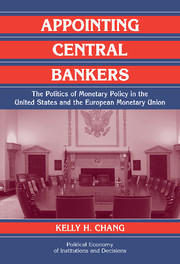 Appointing Central Bankers
Appointing Central Bankers Book contents
- Frontmatter
- Contents
- List of Figures
- List of Tables
- Acknowledgments
- 1 Introduction
- 2 A Formal Model of the Appointment Process
- 3 Estimating Monetary Policy Preferences
- 4 Empirically Testing the Model's Predictions
- 5 Appointments to the European Central Bank
- 6 The Origins of the Federal Reserve Appointment Process
- 7 Conclusions
- Bibliography
- Index
- Titles in the series
6 - The Origins of the Federal Reserve Appointment Process
Published online by Cambridge University Press: 05 September 2009
- Frontmatter
- Contents
- List of Figures
- List of Tables
- Acknowledgments
- 1 Introduction
- 2 A Formal Model of the Appointment Process
- 3 Estimating Monetary Policy Preferences
- 4 Empirically Testing the Model's Predictions
- 5 Appointments to the European Central Bank
- 6 The Origins of the Federal Reserve Appointment Process
- 7 Conclusions
- Bibliography
- Index
- Titles in the series
Summary
In the previous chapters, the appointment process is exogenous; I take the process as given and explain how it affects policy. In this chapter, the appointment process is an endogenous object of choice – a dependent variable. I examine the development of the appointment process and claim that it is related to the centralization of the Federal Reserve System. Specifically, I compare and contrast the different appointment structures envisioned in the banking bills from 1903 to 1935.
THE THEORETICAL FRAMEWORK
Assumptions and Definitions
1. The Dependent Variable: Appointment Power. Appointment power is the extent to which the president and Senate can influence policy through appointments. It is related to the appointment structure, the structure of the appointment process and its effects on policy. The appointment structure's components are:
THE NUMBER OF APPOINTED MEMBERS. This variable refers to the number of members appointed by the president and Senate to the Fed's central decision-making board. On the FOMC, by appointing a larger proportion of the central board, the president and Senate have greater control over its decisions, because there is a greater likelihood that the FOMC median is one of their appointees. Because of political uncertainty, the president and Senate will not necessarily advocate a board composed totally of political appointees. With such a board, once in office, opponents can quickly reverse policy gains made by the current president and Senate.
THE LENGTH OF TERMS. This variable refers to how long each central board member serves.
- Type
- Chapter
- Information
- Appointing Central BankersThe Politics of Monetary Policy in the United States and the European Monetary Union, pp. 116 - 138Publisher: Cambridge University PressPrint publication year: 2003
